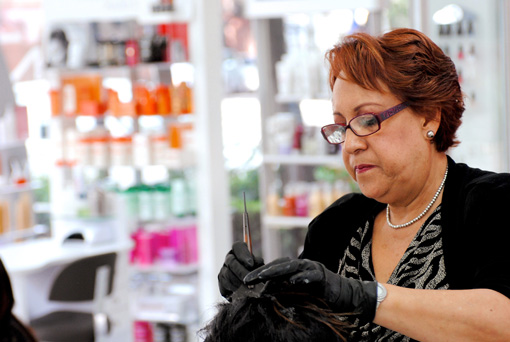Six days a week, María Felicitas Camacho Maya, 62, unlocks the door to Lilian Michel, a bright white salon in Mexico City’s upscale Condesa neighborhood. She slips a white smock over her blouse and checks her hair at an island of oval mirrors.
América Luz Valencia, a 27-year-old manicurist, arrives an hour or so later, her stylish hair sleek as a black onyx blade. Once her first customer for a manicure walks in, she’ll clip, file and polish hands and feet for hours, sometimes without a break.
Both the business owner and her younger employee are aspiring members of Mexico’s diverse and rapidly expanding middle class. They demonstrate the critical role working women now play in their families’ social mobility.
The number of Mexican women working outside the home rose from just over 37 percent in 1980 to nearly 45 percent of Mexico’s workforce in 2008, according to the International Labour Organisation. At the same time, Mexico’s fertility rate plummeted from 5.7 to 2 children per mother between 1976 and 2012, according to Mexico’s statistics agency, INEGI.
Although they belong to two different generations, the stories of María Felicitas and América share common threads: both left rural Mexico for the capital city as teenagers, and both have been instrumental in helping their families prosper financially. At the same time, both women have faced real, structural obstacles to “making it” in the middle class.
María Felicitas left rural Michoacán at age 14 to attend beauty school and was taken in by a female cousin who had already made money working in Mexico City. After landing a job as an assistant in a prestigious salon, she paid for her mother and sister to come to the city, where they worked as maids and lived together in the servants’ quarters of a home in Colonia Roma.
At 20, María Felicitas’ career took off when she got the opportunity to take over a failing beauty salon in Condesa with 100,000 pesos ($7,808) in credit from the building’s owners. It was the salon she used to admire on her way to classes, and it’s the salon she still runs today.
Thanks to revenue from María Felicitas’ new business and income from a café her husband ran, the couple purchased a home in a gated community on the outskirts of Mexico City in 1979, where they raised a family and still live today. After surviving years of economic instability in Mexico by pinching pesos, they managed to put their three children— two daughters and a son—through private schools. That decision, which she describes as “importantísimo,” was rooted more in networking than in the quality of the education. All three children attended private universities on scholarship, one of them funded by the wealthy mother of a school friend.
“We made a huge leap with our children,” she says. “I came from a rural place and my children are professionals!”
Meanwhile, América hopes to someday reach the comfortable status of her employer. As a child growing up in an Indigenous community in southern Chiapas, she remembers her mother telling her, “You were born poor and you will always be poor.” Studies weren’t encouraged. At 16, faced with an imminent arranged marriage, América gambled on a suitor’s offer to come to Mexico City and build a new life.
When she arrived in the city, América spoke only her native Zoque and taught herself Spanish while she attended beauty school. Today, the working mother has catapulted her family into the middle class. She and her husband, a waiter, now own a three-bedroom home in Texcoco with a yard where their children, ages 8 and 3, can play.
América says that she and her husband “share everything, even the chores.” Six days a week, she wakes up before dawn to prepare breakfast for the family and accompany her son to public school before commuting at least two hours by pesero—the metropolitan area’s informal, rattletrap buses—to the salon in Condesa.
América talks proudly of her son, who excels in public school and every day imagines anew what he wants to be when he grows up—the latest choices being “doctor”
or “Olympian.”
Though she laments not being able to spend more time with her children, América says she works hard so that her children will someday have the opportunity to go to college.
“My son understands,” she says, explaining that 8-year-old Diego knows that his mother is working for his benefit.
Despite what they have achieved, both women still worry about their future economic security. María Felicitas, who has no pension, expects to work long hours as long as she is healthy. América has little access to the kind of capital that could allow her to buy her own business.
Yet the risks María Felicitas took in her youth, and the gambles América makes today, show the depth of their belief in their individual ability to provide a vastly improved life for their children. Although challenges remain, each, in her own way, has succeeded.
“I would have liked to study something more or spend more time with my children,” says María Felicitas, tearing up as she considers her regrets. “But I am so thankful for my life.”




